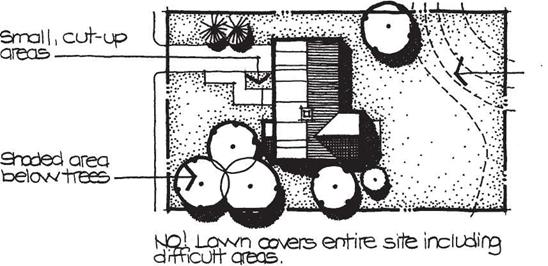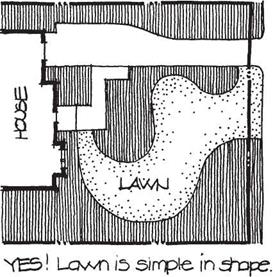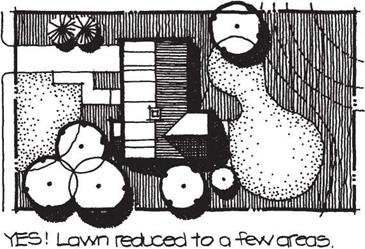A related strategy for reducing water consumption on the residential site is to select native or other similar plant materials that grow unassisted in the regional climate conditions. In addition to the normal consideration of hardiness, attention should be given to when precipitation falls and in what amounts. Many geographic locations have distinct cycles of precipitation with some months of the year being notably wetter or dryer than others, as previously noted. Plants must be compatible with these precipitation patterns, not just annual averages. This frequently means using native plants that are naturally acclimated to the natural precipitation cycles (see “Use Regional Materials” in “Regional Fit” in this chapter). Vegetation that has greater water needs should not be used or should be located in designated moist zones of the site where it can be given sufficient supplemental water.
Another “plant material” that must be thought about in terms of water usage is the lawn. A lawn requires relatively large amounts of water to maintain its health and attractive green carpet appearance. Lawn and the grasses that compose it are only indigenous to cool, wet regions such as those found in the northwestern United States and Great Britain, where lawn evolved as a design element. Lawn does not grow well in other climatic regions without special care.
The lawn has other environmental shortcomings, too. The lawn is an ecological monoculture composed of one plant type, an artificial habitat that rarely exists in nature. By comparison, almost all natural ecosystems are composed of numerous plant and animal species that are interdependent. An ecosystem composed of numerous species is healthy and sustaining because the system can usually survive if one species is harmed or lost. Not so with a lawn. Finally, the height of grass in a lawn is also unreal; most lawn grasses grow 6 to 8 inches in height if let alone. Lawn must of course be regularly mowed at great expense of time and energy to prevent the grasses from reaching their “natural” height.
As a synthetic environment, lawn must be supported by other means to maintain its health and vigor. Consistent watering, fertilization, pest control, and weeding are all necessary to preserve the appearance that is usually expected of a lawn area. This requires time and the input of numerous resources, some of which are environmentally harmful. For example, the pesticides and insecticides used on many lawns are directly harmful to people, especially children, and many birds and animals. The warning tags placed around a lawn after a chemical application are one indication of this. There are numerous reports about people who have become ill, sometimes severely so, after exposure to the chemicals applied to lawns. The quantity of use is also troublesome. About 40 percent of all private lawns are treated with pesticides at a rate that is three to six times more per acre than that used by farmers.[14] The fertilizers applied to lawns to make them grow vigorously are also potentially detrimental to the larger environment. Some of the fertilizer applied to the average lawn is carried away
during a rainstorm and ends up in nearby streams and rivers. Here, the added fertilizer causes algae and other aquatic plants to dramatically grow, ultimately reducing the available oxygen for fish and other marine life. Fish and other aquatic life consequently die, creating a biologically barren marine environment.
 |
Lawn areas on the residential site should therefore be considered carefully because of their demand for water and their other ecological deficiencies. Two general considerations should prevail with lawn areas: (1) reduce the amount of lawn area and (2) maintain lawn in an environmentally responsive manner. To reduce lawn area on the residential site, lawn should be located only in carefully selected areas of the site (bottom half of Figure 3—39). The remainder of the site can be designated for other uses and/or planted with other types of vegetation. Lawn should not be used on the ground plane in shaded areas below tree canopies, on slopes over a 3:1 gradient, in small pieces here and there, or in long narrow spaces, such as along the side of the house near the property line (top half of Figure 3—39). Lawn is difficult to grow and maintain in these instances. These areas are best covered with another material such as ground cover or, in some instances, porous pavement.
|
Figure 3-39 Lawn areas should be reduced in size and located only in relatively open and level areas. |
|

![]() Areas where lawn is located should be well-defined, simply shaped areas (Figure 3-40). Uncomplicated and curved lawn edges are the easiest to mow along. Therefore, complex edges or right-angle corners should be avoided whenever possible. Additionally, the lawn should be relatively free of elements such as trees, light poles, boulders, and birdbaths, which act as obstacles for a lawn mower.
Areas where lawn is located should be well-defined, simply shaped areas (Figure 3-40). Uncomplicated and curved lawn edges are the easiest to mow along. Therefore, complex edges or right-angle corners should be avoided whenever possible. Additionally, the lawn should be relatively free of elements such as trees, light poles, boulders, and birdbaths, which act as obstacles for a lawn mower.
A number of lawn substitutes ought to be considered as alternatives to lawn. One is other low-growing, native grasses that can be found in almost all climatic regions. These grasses, such as red fescue (northern states), buffalo grass (Midwest prairie region), and California meadow sedge (West Coast), have the general appearance of lawn but do not require frequent mowing or watering.[15] A meadow of wild – flowers and native grasses is another alternative, especially for relatively large areas. A meadow can offer a sense of change with its distinct seasons in addition to the splash of color it provides in the summer. An area with ornamental grasses of varied heights, textures, and colors can likewise provide a dramatic alternative to the conventional lawn. Ornamental grasses have visual appeal throughout the year and provide a soft texture that moves in the wind. A native prairie is similar and a possible substitute in many midwestern states. A wide range of cultivated ground covers can also occupy large areas of ground on a residential site instead of lawn. Finally, arid regions often incorporate gravel and decomposed granite as substitutes for the lawn. So, there are numerous options that offer creative solutions to providing a vegetative cover that have distinct environmental advantages compared to lawn.





